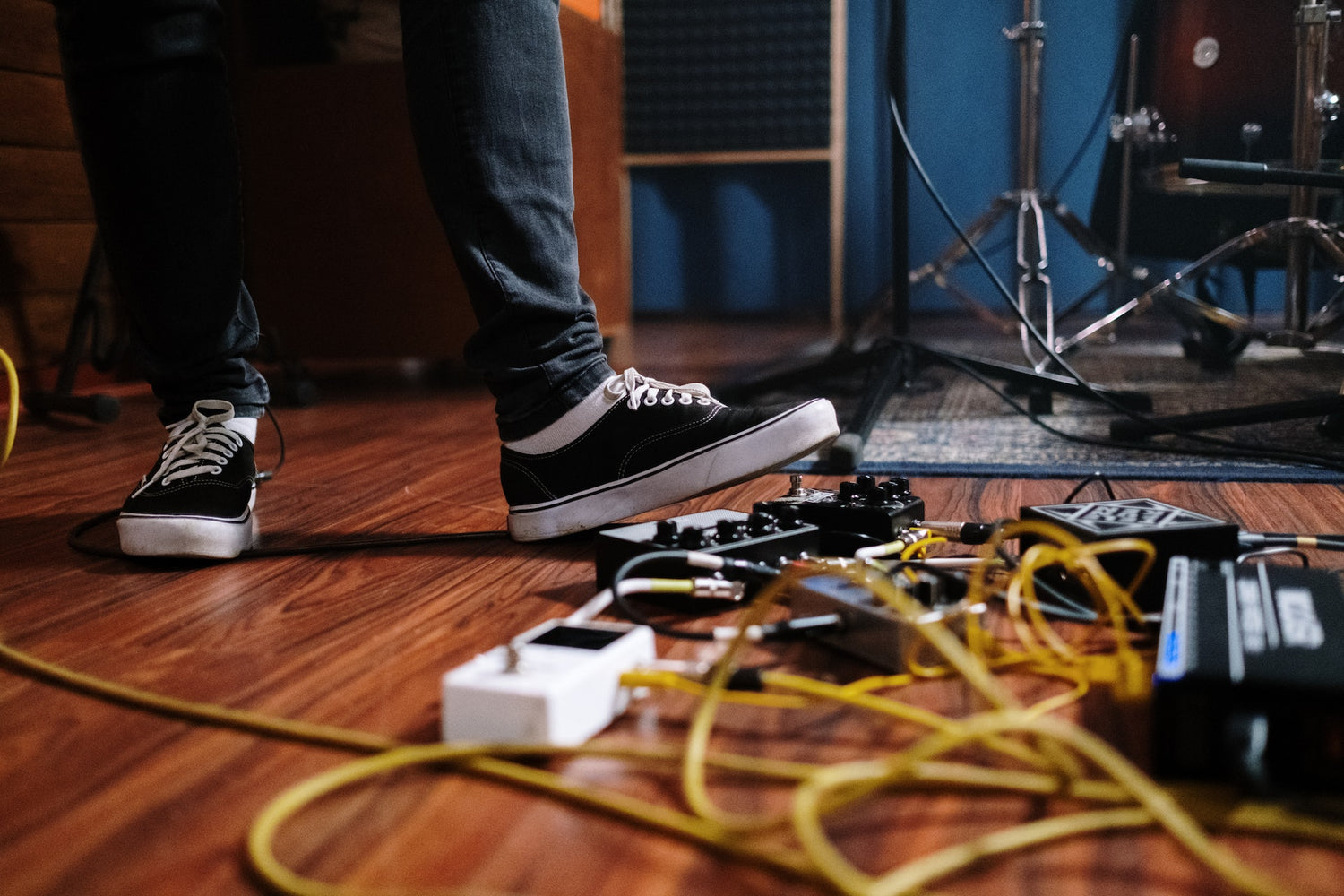As guitarists, we have a habit of focusing on instruments, amplifiers, and recording equipment. Yet, lurking in the shadows, playing a silent but pivotal role, are audio cables.
These unsung heroes of the audio world ensure that the music's soul travels unblemished from source to listener. But what makes a quality audio cable stand out? And how can you tell if your trusted cable is on the brink of failure? Journey with us as we unravel the science, signs, and stories behind audio cables, drawing from technical insights and personal experiences.
The Science Behind Audio Cables
When we think of our audio setup, be it a home theater system, a professional recording studio, or a simple guitar rig, cables might not be the first thing that comes to mind. However, these seemingly inconspicuous components play a pivotal role in shaping the sound we hear.
At the heart of every audio system lies the signal - the music, the voice, the sound effects. This signal travels through various components, and the cables are the highways for these signals. Just as a smooth, wide highway allows for efficient and fast movement of vehicles, a good quality audio cable ensures that the audio signal travels without hindrance or loss of quality.
To appreciate the nuances of audio cables, we need to understand some fundamental electrical engineering principles that govern their operation.
Every strum of a guitar, every note sung, every beat of a drum is transformed into an electrical signal. This signal, representing the sound wave, travels through the audio cable. The fidelity and strength of this transmission are paramount. Any loss or alteration can change the sound's character, sometimes subtly, sometimes drastically.
There are a few different ways that a cable can alter your signal, starting with resistance.
Resistance:
Imagine walking through water. The deeper the water, the harder it is to walk. That's resistance in the world of audio cables. It's the opposition faced by the signal as it travels. Factors influencing resistance include:
- Material: Copper is a common choice for audio cables due to its excellent conductivity. However, materials like silver, while more expensive, offer even better conductivity.
- Thickness: A thicker cable, often denoted by a lower gauge number, provides a wider path for the signal, resulting in lower resistance.
- Length: The longer the cable, the more material the signal has to pass through, increasing resistance. Generally under 20’ won’t impact the tone, but above that, and especially above 30’ you’ll start to notice some of the treble roll off.
Sound Implications:
A cable with high resistance might attenuate the signal, especially over longer distances. This can lead to a sound that's quieter or lacks dynamism. On the tonal front, high resistance can sometimes reduce the brightness or "sparkle" in the sound, making it sound warmer or muddier.

Capacitance:
Capacitance refers to the cable's ability to store an electrical charge. In audio cables, capacitance can influence the transmission of higher frequencies. Factors affecting capacitance include:
- Insulation Material: Different insulating materials have different dielectric constants, which can influence the cable's capacitance. For instance, materials like polyethylene tend to have lower capacitance than PVC.
- Cable Geometry: The way conductors are arranged in the cable, their spacing, and the thickness of the insulation can all impact capacitance. Twisted pair cables, for example, can have different capacitance values compared to parallel conductor designs.
- Shielding: The type and effectiveness of shielding can also play a role in a cable's capacitance. Foil shields, for instance, can increase capacitance due to their proximity to the cable's conductors.
Sound Implications:
A cable with high capacitance might roll off some of the higher frequencies, leading to a warmer sound. This can be desirable for some instruments or vocals but might not be ideal for those seeking a bright, detailed sound.
Inductance:
Inductance is the property of an electrical conductor to oppose a change in the electric current passing through it. In audio cables, it can affect the transmission of lower frequencies. Factors influencing inductance include:
- Cable Length: 20’ or longer cables inherently have higher inductance simply because there's more material for the signal to pass through.
- Cable Geometry: Just as with capacitance, the arrangement and spacing of conductors can influence inductance. Coaxial cables, for instance, tend to have lower inductance than other designs due to their concentric conductor arrangement.
- Conductor Size: Thicker conductors (lower gauge) can reduce inductance, as there's a larger area for the signal to flow.
Sound Implications:
While inductance is generally less of a concern in most audio setups, especially over short distances, very high inductance can lead to a reduction in bass response, making the sound thinner.
Signs of a Quality Audio Cable
Building on our understanding of the electrical principles that govern audio cables, it becomes clear that not all cables are created equal. While they might often be overshadowed by flashier pieces of equipment, seasoned musicians and audiophiles know that a cable's quality can profoundly influence sound. So, with the science in mind, how do we identify a truly exceptional audio cable? Let's delve into the hallmarks of quality, enriched by both technical insights and personal experiences.
Material and Construction:
Conductors are the heart of any cable, transmitting the electrical signals that represent sound. High-purity metals, such as oxygen-free copper or even silver, are sought after for their ability to ensure minimal resistance and optimal signal transmission. The purity and conductivity of these metals play a pivotal role in preserving the integrity of the sound.
Insulation is another critical component. While its primary role is to isolate the conductor and prevent short circuits, the choice of insulating material can have sonic implications. For instance, cables insulated with polyethylene tend to offer lower capacitance compared to those using materials like PVC. This reduced capacitance can help maintain the integrity of higher frequencies, ensuring a clearer and more detailed sound.
Shielding is the unsung hero of audio cables. Its primary role is to guard the cable against external interferences, such as electromagnetic fields or radio frequencies. Effective shielding, whether it's braided, foil, or a combination of both, is vital. A well-shielded cable stands as a bulwark against hums, buzzes, and other unwanted noises, ensuring a clean and interference-free sound.
When it comes to connectors, there's often a debate between gold-plated and regular metal variants. Gold, with its superior conductivity and resistance to corrosion, is a favored choice for high-quality audio connectors. These gold-plated connectors, while ensuring a reliable and low-resistance connection, are often backed by a base metal like brass or copper. Since the gold is just a thin layer over another metal (commonly brass or nickel), one might wonder if this combination could introduce any interference or signal degradation.
In theory, when two different metals are in contact, there's a potential for a very tiny voltage to be generated at the junction due to the metals' differing electron affinities. This phenomenon is known as a "galvanic potential" or "contact potential." In a highly sensitive setting, like precision electronic measurements, this could be a concern. However, in the context of audio connectors, this effect is negligible.
In general, the difference between the two connector types is likely to be less noticeable than any of the other factors we’ve discussed.

How to Identify a Failing Audio Cable
Audio cables, like all components of an audio setup, have a lifespan. Over time, due to wear and tear, environmental factors, or manufacturing defects, a cable can start to degrade. Recognizing the signs of a failing cable early can save you from unexpected disruptions during performances or recording sessions. Here's how to spot a cable that's on its way out:
1. Intermittent Sound:
One of the most common signs of a failing cable is intermittent sound. If you find the audio cutting in and out or notice sudden drops in volume, there's a good chance your cable might be the culprit. This can be due to internal breaks in the cable's conductor or issues with the connectors.
2. Noticeable Noise:
A healthy cable should transmit sound without adding any noise. If you start hearing hums, buzzes, or static when using a particular cable, it might be deteriorating. This noise can be due to compromised shielding, allowing external interferences to creep in.
3. Physical Damage:
Always inspect your cables for visible signs of wear and tear. Look for kinks, fraying, or any damage to the insulation. Exposed conductors not only pose a risk of short circuits but can also degrade sound quality.
Protecting Your Cables with Cabli:
One of the best ways to extend the life of your cables and protect them from physical damage is by using tools designed for cable care, like the Cabli. The Cabli ensures that your cables are wound and stored correctly, preventing kinks and reducing wear. By maintaining a consistent and safe winding pattern, the Cabli not only helps in organizing your cables but also plays a crucial role in preserving their integrity and sound quality.
4. Connector Issues:
If plugging in or unplugging the cable produces crackling sounds or if the connectors feel loose, it's a sign that they might be worn out or damaged. The soldering inside the connectors can also degrade over time, leading to poor connections.
5. Coloration of Sound:
A failing cable can sometimes introduce tonal colorations. If your instrument or audio source suddenly sounds different – perhaps muddier or lacking in treble – it's worth checking if the cable is the cause.
6. Testing with a Multimeter:
If you have access to a multimeter, you can test the cable for continuity. Set the multimeter to the continuity setting, and touch the probes to the respective ends of the cable (tip to tip, sleeve to sleeve). If the multimeter doesn't register continuity, there's a break somewhere in the cable.
I've had my fair share of cable issues over the years. One memorable incident involved a guitar cable that seemed perfectly fine when playing clean tones. However, when I tried to introduce some distortion, the signal just wouldn't break up. It took me a while to realize that, while the cable was transmitting sound, the signal strength was compromised. The cable was failing, and it was affecting the dynamics of my playing.
Conclusion
Audio cables might not command the same attention as a vintage guitar or a state-of-the-art amplifier, but their role is undeniable. As we've journeyed through the intricacies of audio cables, from the science that governs them to the tales of their impact, one thing is clear: never underestimate the power of the unseen. As you plug in and play, take a moment to appreciate these silent workhorses.




Leave a comment
All comments are moderated before being published.
This site is protected by hCaptcha and the hCaptcha Privacy Policy and Terms of Service apply.